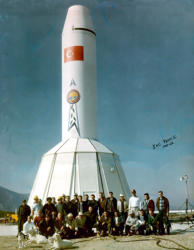HISTORY - Page 42
would be deployed would have little room for maneuvering. The Air Force was pinning all of its plans on
attaining a 15-minute readiness capability for all weapons. ABMA did see some future in the turn of events
occasioned by the Air Force's reorganization in that it would now be a contractor for an operational user
and would not have to extensively coordinate with a lateral development agency to reach the user. In this
respect, thought was given to the possibility of certifying a liaison office to the SAC element in charge of
the IRBM missile program
54
.
By mid-December, the picture as to the eventual use of the JUPITER became a little clearer through an Air
Force briefing presented in Washington. Deployment plans called for four squadrons, with the first
squadron being equipped with six launchers and 15 missiles. Six missiles would be fired in 30 minutes, and
the remainder within 2 1/2 hours. Thereafter, the succeeding squadrons would have 15 launchers and 15
missiles, all capable of firing within 15 minutes. Other stipulations included Air Force manning, capability
to deploy to strategic locations (some notice of mobility), capability of continuous operation, minimum
vulnerability, and fast reaction time (15-minute salvo). The Army was still dubious about the lack of
mobility and being able to deploy by December 1958, unless Army personnel were used to man the
system
55
.
Subsequent to the briefing, Secretary Brucker forwarded a memo to the Secretary of the Air Force outlining
Army plans to meet Air Force requirements. Again, the question was raised as to the ability to deploy in
_____________________________







54. Msg, (ABMA/AFBMD 6171, ABMA FIDO at AFBMD to ABMA, 6 Dec 57, subj: Info on THOR/JUP Plans & SAC Plans, Hist Off files.
55. Msg, Col T. T. Paul to Gen Medaris, 17 Dec 57, subj: AF Planning



Jupiter SM-78 Weapon System
I&C Team 2, Çigli AB, Turkey 1961-1962 Chrysler Corporation Missile Division

HISTORY - Page 42
would be deployed would have little room for
maneuvering. The Air Force was pinning all of its plans
on attaining a 15-minute readiness capability for all
weapons. ABMA did see some future in the turn of
events occasioned by the Air Force's reorganization in
that it would now be a contractor for an operational
user and would not have to extensively coordinate
with a lateral development agency to reach the user.
In this respect, thought was given to the possibility of
certifying a liaison office to the SAC element in charge
of the IRBM missile program
54
.
By mid-December, the picture as to the eventual use of
the JUPITER became a little clearer through an Air
Force briefing presented in Washington. Deployment
plans called for four squadrons, with the first
squadron being equipped with six launchers and 15
missiles. Six missiles would be fired in 30 minutes, and
the remainder within 2 1/2 hours. Thereafter, the
succeeding squadrons would have 15 launchers and 15
missiles, all capable of firing within 15 minutes. Other
stipulations included Air Force manning, capability to
deploy to strategic locations (some notice of mobility),
capability of continuous operation, minimum
vulnerability, and fast reaction time (15-minute salvo).
The Army was still dubious about the lack of mobility
and being able to deploy by December 1958, unless
Army personnel were used to man the system
55
.
Subsequent to the briefing, Secretary Brucker
forwarded a memo to the Secretary of the Air Force
outlining Army plans to meet Air Force requirements.
Again, the question was raised as to the ability to
deploy in
_____________________________
54. Msg, (ABMA/AFBMD 6171, ABMA FIDO at AFBMD to ABMA, 6 Dec 57, subj: Info on
THOR/JUP Plans & SAC Plans, Hist Off files.
55. Msg, Col T. T. Paul to Gen Medaris, 17 Dec 57, subj: AF Planning





















